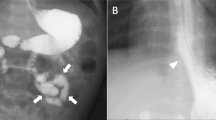Abstract
Megacystis–microcolon–intestinal hypoperistalsis syndrome (MMIHS) is a rare, often fatal condition. Infants present with a functional obstruction of the gastrointestinal tract (GI), malrotation, microcolon, and a large nonobstructed bladder. Several features common to both MMIHS and Eagle–Barrett or prune belly syndrome (PBS) include hydronephrosis, bladder distension and laxity of the abdominal wall musculature. Additionally, MMIHS and PBS have been reported in the same family, suggesting the possibility of a common pathogenesis. MMIHS usually presents in female infants. We present a male infant diagnosed with both MMIHS and PBS. This is a unique case in which both MMIHS and true PBS are present in the same infant.



Similar content being viewed by others
References
Granata C, Puri P (1997) Megacystis–microcolon–intestinal hypoperistalsis syndrome. J Pediatr Gastroenterol Nutr 25:12–19
Olivereira G, Boechat MI, Ferreira MA (1983) Megacystis–microcolon–intestinal hypoperistalsis syndrome in a newborn girl whose brother had prune belly: common pathogenesis? Pediatr Radiol 13:294–296
Berdon WE, Baker DH, Blanc WA, et al (1976) Megacystis–microcolon–intestinal hypoperistalsis syndrome: a new cause of intestinal obstruction in the newborn: report of radiologic findings in five newborn girls. AJR 126:957–964
Anneren G, Meurling S, Olsen L (1991) Megacystis–microcolon–intestinal hypoperistalsis syndrome (MMIHS), an autosomal recessive disorder: clinical reports and review of the literature. Am J Med Genet 41:251–254
Masetti M, Rodriguez MM, Thompson JF, et al (1999) Multivisceral transplantation in Megacystis–microcolon–intestinal hypoperistalsis syndrome. Transplantation 68:228–232
Jennings RW (2000) Prune belly syndrome. Semin Pediatr Surg 9:115–120
Das Narla L, Doherty RD, Hingsbergen EA, et al (1998) Pediatric case of the day. Radiographics 18:1318–1322
Chen CP, Wang TY, Chuang CY (1998) Sonographic findings in a fetus with Megacystis–microcolon–intestinal hypoperistalsis syndrome. J Clin Ultrasound 26:217–220
Garber A, Shohat M, Sarti D (1990) Megacystis–microcolon–intestinal hypoperistalsis syndrome in two male siblings. Prenat Diagn 10:377–387
Rolle U, O’Briain S, Pearl R, et al (2002) Megacystis–microcolon–intestinal hypoperistalsis syndrome: evidence of intestinal myopathy. Pediatr Surg Int 18:2–5
Piotrowska AP, Rolle U, Chertin B, et al (2003) Alterations in smooth muscle contractile and cytoskeleton proteins and interstitial cells of Cajal in Megacystis–microcolon–intestinal hypoperistalsis syndrome. J Pediatr Surg 38:749–755
Lev-Lehman E, Bercovich D, Xu W, et al (2001) Characterization of the human beta4 nAChR gene and polymorphisms in CHRNA3 and CHRNB4. J Hum Genet 46:362–366
Author information
Authors and Affiliations
Corresponding author
Rights and permissions
About this article
Cite this article
Levin, T.L., Soghier, L., Blitman, N.M. et al. Megacystis–microcolon–intestinal hypoperistalsis and prune belly: overlapping syndromes. Pediatr Radiol 34, 995–998 (2004). https://doi.org/10.1007/s00247-004-1260-2
Received:
Revised:
Accepted:
Published:
Issue Date:
DOI: https://doi.org/10.1007/s00247-004-1260-2




